2017 NISSAN LEAF stop start
[x] Cancel search: stop startPage 324 of 424
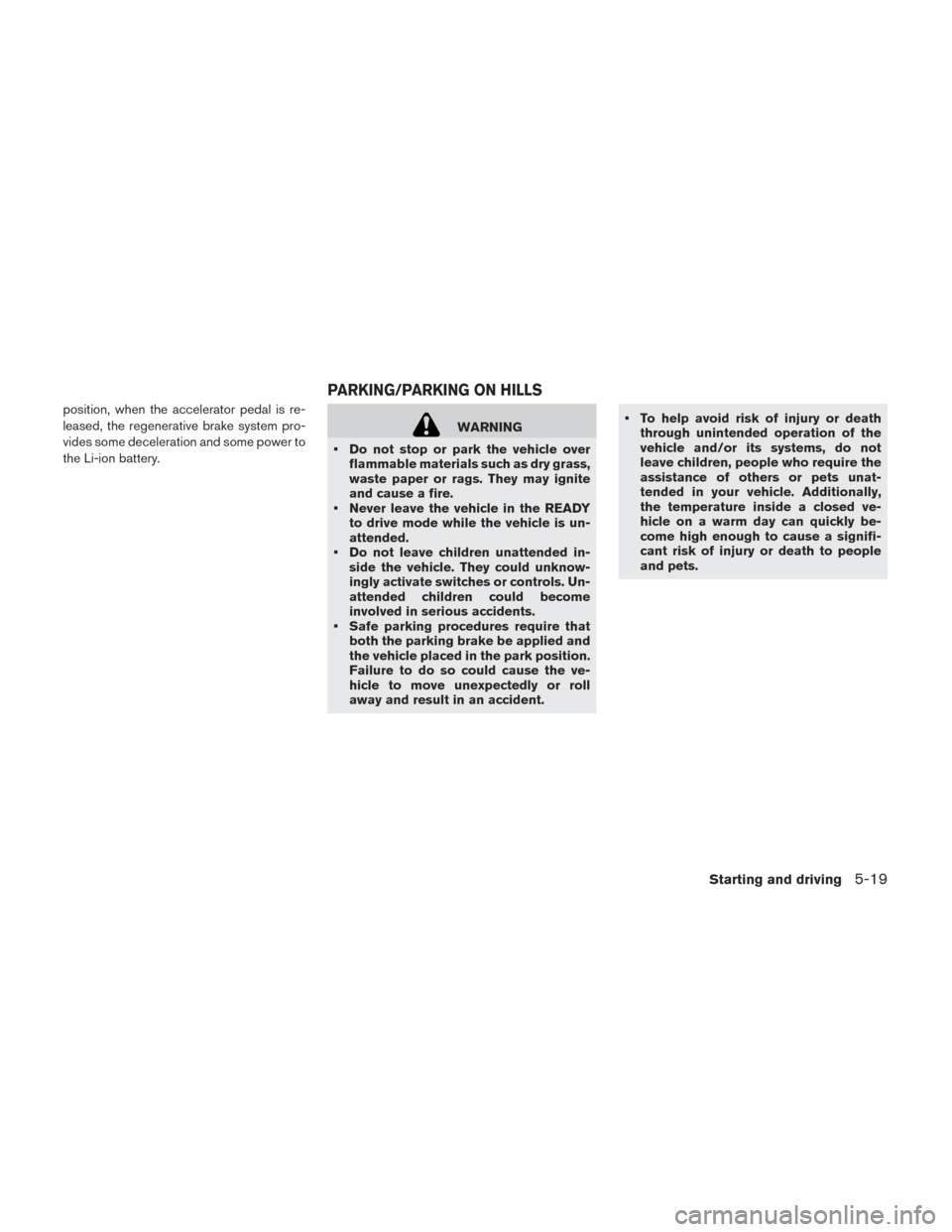
position, when the accelerator pedal is re-
leased, the regenerative brake system pro-
vides some deceleration and some power to
the Li-ion battery.
WARNING
• Do not stop or park the vehicle over flammable materials such as dry grass,
waste paper or rags. They may ignite
and cause a fire.
• Never leave the vehicle in the READY to drive mode while the vehicle is un-
attended.
• Do not leave children unattended in- side the vehicle. They could unknow-
ingly activate switches or controls. Un-
attended children could become
involved in serious accidents.
• Safe parking procedures require that both the parking brake be applied and
the vehicle placed in the park position.
Failure to do so could cause the ve-
hicle to move unexpectedly or roll
away and result in an accident. • To help avoid risk of injury or death
through unintended operation of the
vehicle and/or its systems, do not
leave children, people who require the
assistance of others or pets unat-
tended in your vehicle. Additionally,
the temperature inside a closed ve-
hicle on a warm day can quickly be-
come high enough to cause a signifi-
cant risk of injury or death to people
and pets.
PARKING/PARKING ON HILLS
Starting and driving5-19
Page 326 of 424
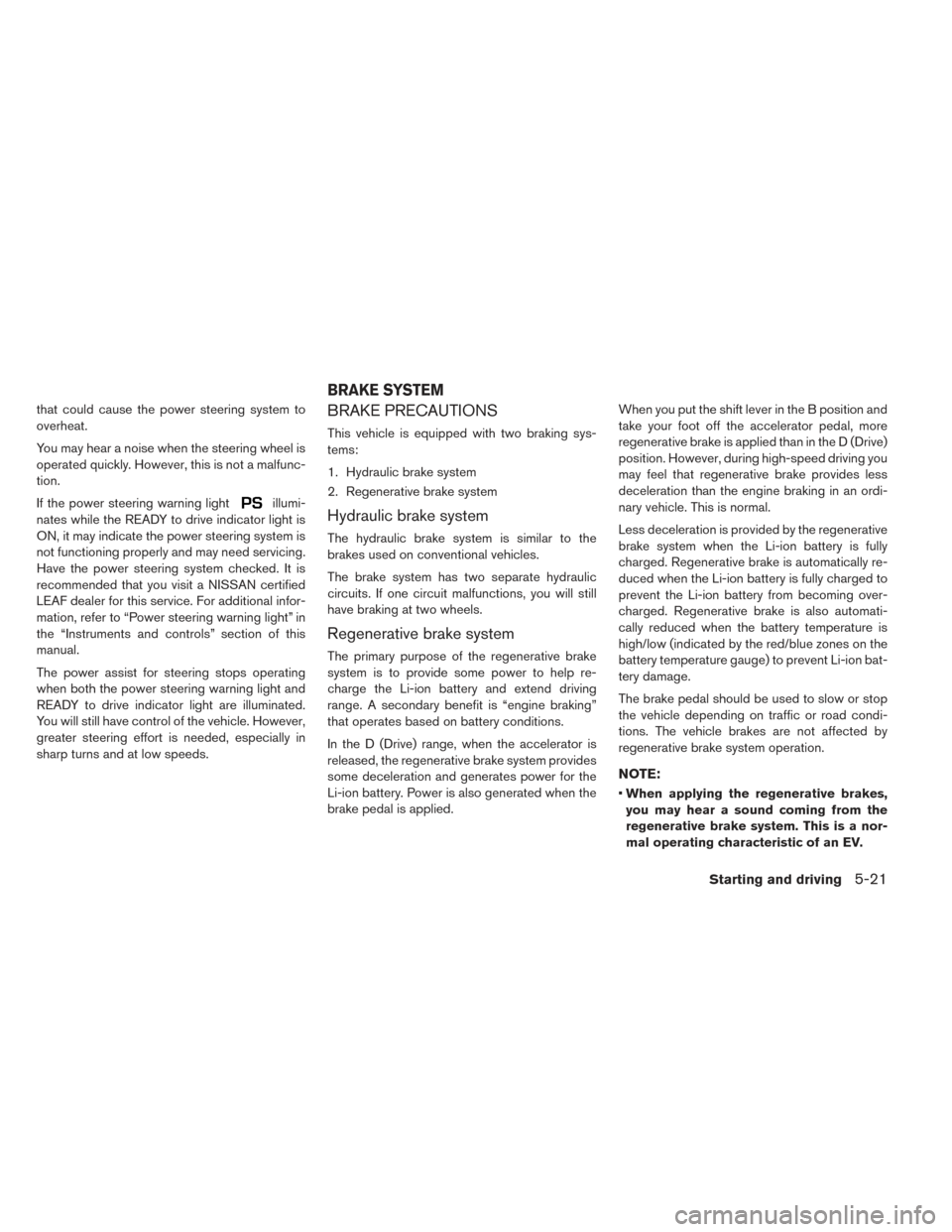
that could cause the power steering system to
overheat.
You may hear a noise when the steering wheel is
operated quickly. However, this is not a malfunc-
tion.
If the power steering warning light
illumi-
nates while the READY to drive indicator light is
ON, it may indicate the power steering system is
not functioning properly and may need servicing.
Have the power steering system checked. It is
recommended that you visit a NISSAN certified
LEAF dealer for this service. For additional infor-
mation, refer to “Power steering warning light” in
the “Instruments and controls” section of this
manual.
The power assist for steering stops operating
when both the power steering warning light and
READY to drive indicator light are illuminated.
You will still have control of the vehicle. However,
greater steering effort is needed, especially in
sharp turns and at low speeds.
BRAKE PRECAUTIONS
This vehicle is equipped with two braking sys-
tems:
1. Hydraulic brake system
2. Regenerative brake system
Hydraulic brake system
The hydraulic brake system is similar to the
brakes used on conventional vehicles.
The brake system has two separate hydraulic
circuits. If one circuit malfunctions, you will still
have braking at two wheels.
Regenerative brake system
The primary purpose of the regenerative brake
system is to provide some power to help re-
charge the Li-ion battery and extend driving
range. A secondary benefit is “engine braking”
that operates based on battery conditions.
In the D (Drive) range, when the accelerator is
released, the regenerative brake system provides
some deceleration and generates power for the
Li-ion battery. Power is also generated when the
brake pedal is applied. When you put the shift lever in the B position and
take your foot off the accelerator pedal, more
regenerative brake is applied than in the D (Drive)
position. However, during high-speed driving you
may feel that regenerative brake provides less
deceleration than the engine braking in an ordi-
nary vehicle. This is normal.
Less deceleration is provided by the regenerative
brake system when the Li-ion battery is fully
charged. Regenerative brake is automatically re-
duced when the Li-ion battery is fully charged to
prevent the Li-ion battery from becoming over-
charged. Regenerative brake is also automati-
cally reduced when the battery temperature is
high/low (indicated by the red/blue zones on the
battery temperature gauge) to prevent Li-ion bat-
tery damage.
The brake pedal should be used to slow or stop
the vehicle depending on traffic or road condi-
tions. The vehicle brakes are not affected by
regenerative brake system operation.
NOTE:
•
When applying the regenerative brakes,
you may hear a sound coming from the
regenerative brake system. This is a nor-
mal operating characteristic of an EV.
BRAKE SYSTEM
Starting and driving5-21
Page 327 of 424
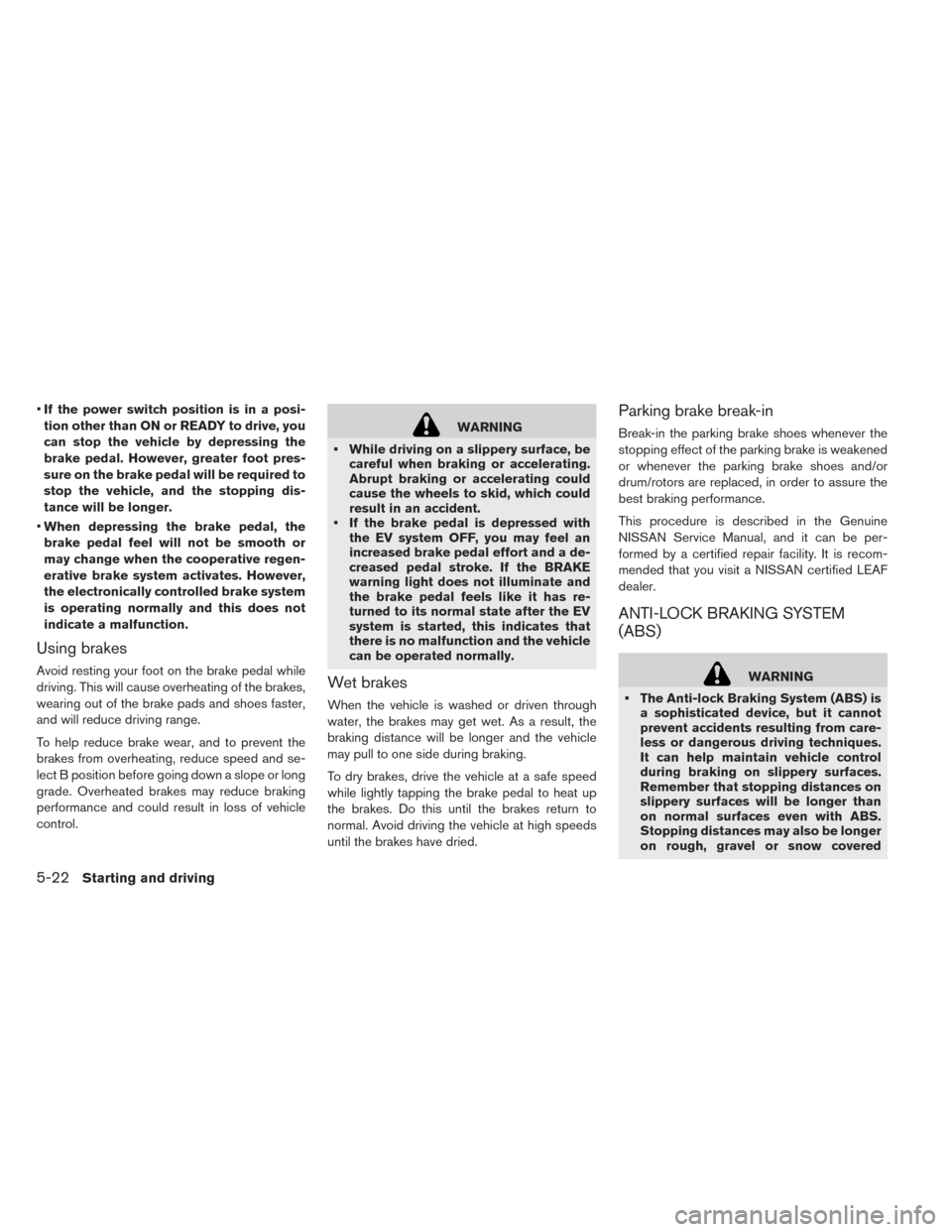
•If the power switch position is in a posi-
tion other than ON or READY to drive, you
can stop the vehicle by depressing the
brake pedal. However, greater foot pres-
sure on the brake pedal will be required to
stop the vehicle, and the stopping dis-
tance will be longer.
• When depressing the brake pedal, the
brake pedal feel will not be smooth or
may change when the cooperative regen-
erative brake system activates. However,
the electronically controlled brake system
is operating normally and this does not
indicate a malfunction.
Using brakes
Avoid resting your foot on the brake pedal while
driving. This will cause overheating of the brakes,
wearing out of the brake pads and shoes faster,
and will reduce driving range.
To help reduce brake wear, and to prevent the
brakes from overheating, reduce speed and se-
lect B position before going down a slope or long
grade. Overheated brakes may reduce braking
performance and could result in loss of vehicle
control.
WARNING
• While driving on a slippery surface, be careful when braking or accelerating.
Abrupt braking or accelerating could
cause the wheels to skid, which could
result in an accident.
• If the brake pedal is depressed with the EV system OFF, you may feel an
increased brake pedal effort and a de-
creased pedal stroke. If the BRAKE
warning light does not illuminate and
the brake pedal feels like it has re-
turned to its normal state after the EV
system is started, this indicates that
there is no malfunction and the vehicle
can be operated normally.
Wet brakes
When the vehicle is washed or driven through
water, the brakes may get wet. As a result, the
braking distance will be longer and the vehicle
may pull to one side during braking.
To dry brakes, drive the vehicle at a safe speed
while lightly tapping the brake pedal to heat up
the brakes. Do this until the brakes return to
normal. Avoid driving the vehicle at high speeds
until the brakes have dried.
Parking brake break-in
Break-in the parking brake shoes whenever the
stopping effect of the parking brake is weakened
or whenever the parking brake shoes and/or
drum/rotors are replaced, in order to assure the
best braking performance.
This procedure is described in the Genuine
NISSAN Service Manual, and it can be per-
formed by a certified repair facility. It is recom-
mended that you visit a NISSAN certified LEAF
dealer.
ANTI-LOCK BRAKING SYSTEM
(ABS)
WARNING
• The Anti-lock Braking System (ABS) is a sophisticated device, but it cannot
prevent accidents resulting from care-
less or dangerous driving techniques.
It can help maintain vehicle control
during braking on slippery surfaces.
Remember that stopping distances on
slippery surfaces will be longer than
on normal surfaces even with ABS.
Stopping distances may also be longer
on rough, gravel or snow covered
5-22Starting and driving
Page 328 of 424
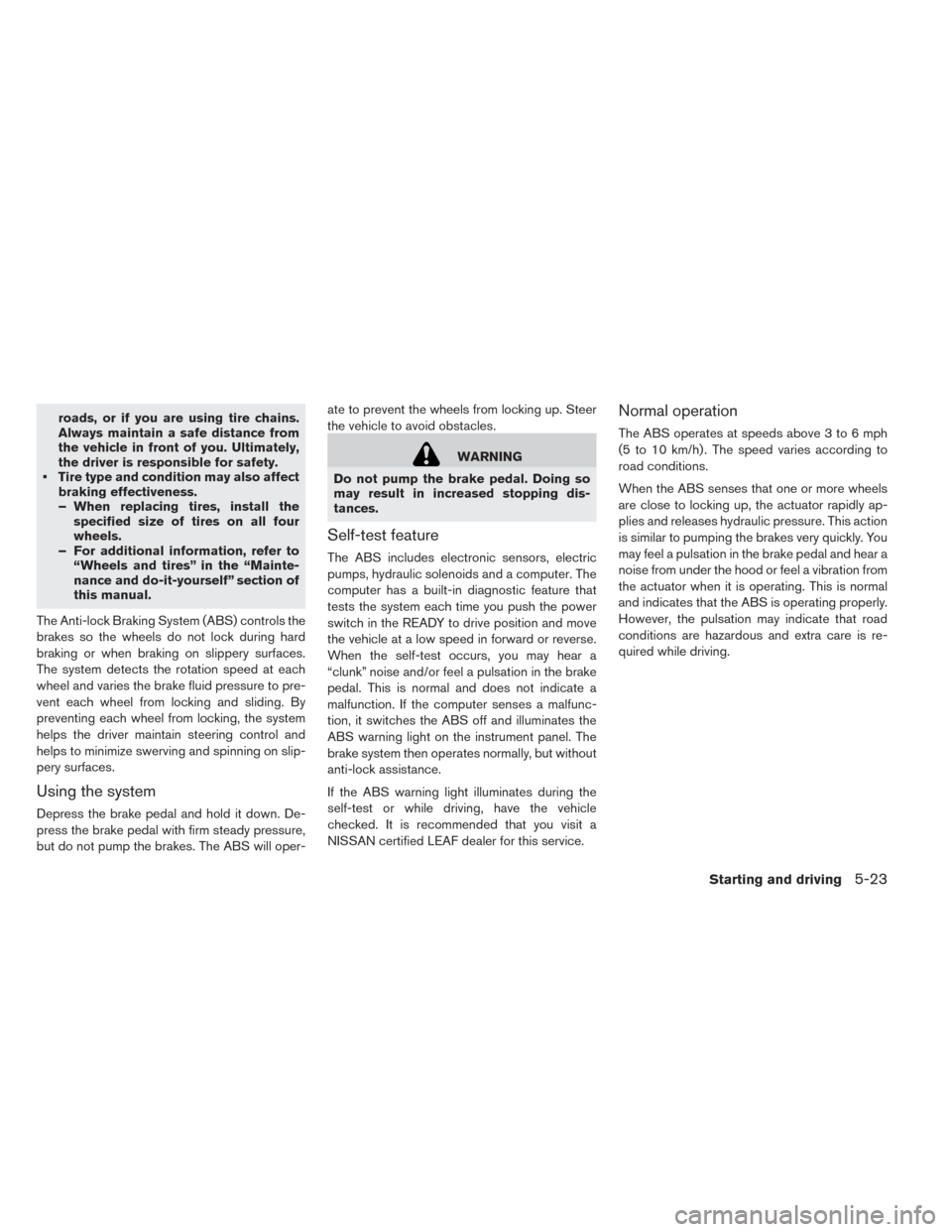
roads, or if you are using tire chains.
Always maintain a safe distance from
the vehicle in front of you. Ultimately,
the driver is responsible for safety.
• Tire type and condition may also affect braking effectiveness.
– When replacing tires, install thespecified size of tires on all four
wheels.
– For additional information, refer to “Wheels and tires” in the “Mainte-
nance and do-it-yourself” section of
this manual.
The Anti-lock Braking System (ABS) controls the
brakes so the wheels do not lock during hard
braking or when braking on slippery surfaces.
The system detects the rotation speed at each
wheel and varies the brake fluid pressure to pre-
vent each wheel from locking and sliding. By
preventing each wheel from locking, the system
helps the driver maintain steering control and
helps to minimize swerving and spinning on slip-
pery surfaces.
Using the system
Depress the brake pedal and hold it down. De-
press the brake pedal with firm steady pressure,
but do not pump the brakes. The ABS will oper- ate to prevent the wheels from locking up. Steer
the vehicle to avoid obstacles.
WARNING
Do not pump the brake pedal. Doing so
may result in increased stopping dis-
tances.
Self-test feature
The ABS includes electronic sensors, electric
pumps, hydraulic solenoids and a computer. The
computer has a built-in diagnostic feature that
tests the system each time you push the power
switch in the READY to drive position and move
the vehicle at a low speed in forward or reverse.
When the self-test occurs, you may hear a
“clunk” noise and/or feel a pulsation in the brake
pedal. This is normal and does not indicate a
malfunction. If the computer senses a malfunc-
tion, it switches the ABS off and illuminates the
ABS warning light on the instrument panel. The
brake system then operates normally, but without
anti-lock assistance.
If the ABS warning light illuminates during the
self-test or while driving, have the vehicle
checked. It is recommended that you visit a
NISSAN certified LEAF dealer for this service.
Normal operation
The ABS operates at speeds above 3 to 6 mph
(5 to 10 km/h) . The speed varies according to
road conditions.
When the ABS senses that one or more wheels
are close to locking up, the actuator rapidly ap-
plies and releases hydraulic pressure. This action
is similar to pumping the brakes very quickly. You
may feel a pulsation in the brake pedal and hear a
noise from under the hood or feel a vibration from
the actuator when it is operating. This is normal
and indicates that the ABS is operating properly.
However, the pulsation may indicate that road
conditions are hazardous and extra care is re-
quired while driving.
Starting and driving5-23
Page 330 of 424
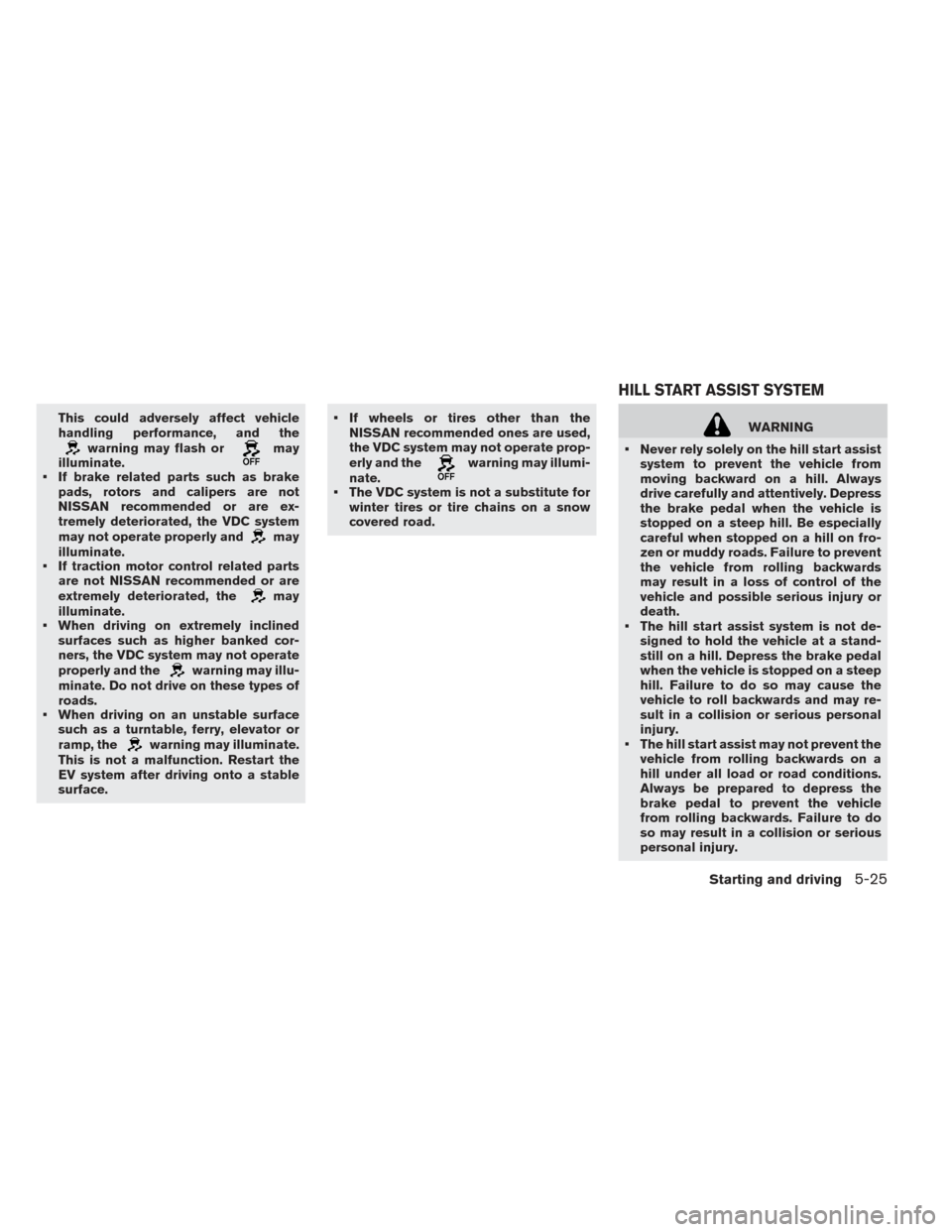
This could adversely affect vehicle
handling performance, and the
warning may flash ormay
illuminate.
• If brake related parts such as brake
pads, rotors and calipers are not
NISSAN recommended or are ex-
tremely deteriorated, the VDC system
may not operate properly and
may
illuminate.
• If traction motor control related parts
are not NISSAN recommended or are
extremely deteriorated, the
may
illuminate.
• When driving on extremely inclined
surfaces such as higher banked cor-
ners, the VDC system may not operate
properly and the
warning may illu-
minate. Do not drive on these types of
roads.
• When driving on an unstable surface
such as a turntable, ferry, elevator or
ramp, the
warning may illuminate.
This is not a malfunction. Restart the
EV system after driving onto a stable
surface. • If wheels or tires other than the
NISSAN recommended ones are used,
the VDC system may not operate prop-
erly and the
warning may illumi-
nate.
• The VDC system is not a substitute for
winter tires or tire chains on a snow
covered road.
WARNING
• Never rely solely on the hill start assist system to prevent the vehicle from
moving backward on a hill. Always
drive carefully and attentively. Depress
the brake pedal when the vehicle is
stopped on a steep hill. Be especially
careful when stopped on a hill on fro-
zen or muddy roads. Failure to prevent
the vehicle from rolling backwards
may result in a loss of control of the
vehicle and possible serious injury or
death.
• The hill start assist system is not de- signed to hold the vehicle at a stand-
still on a hill. Depress the brake pedal
when the vehicle is stopped on a steep
hill. Failure to do so may cause the
vehicle to roll backwards and may re-
sult in a collision or serious personal
injury.
• The hill start assist may not prevent the vehicle from rolling backwards on a
hill under all load or road conditions.
Always be prepared to depress the
brake pedal to prevent the vehicle
from rolling backwards. Failure to do
so may result in a collision or serious
personal injury.
HILL START ASSIST SYSTEM
Starting and driving5-25
Page 331 of 424
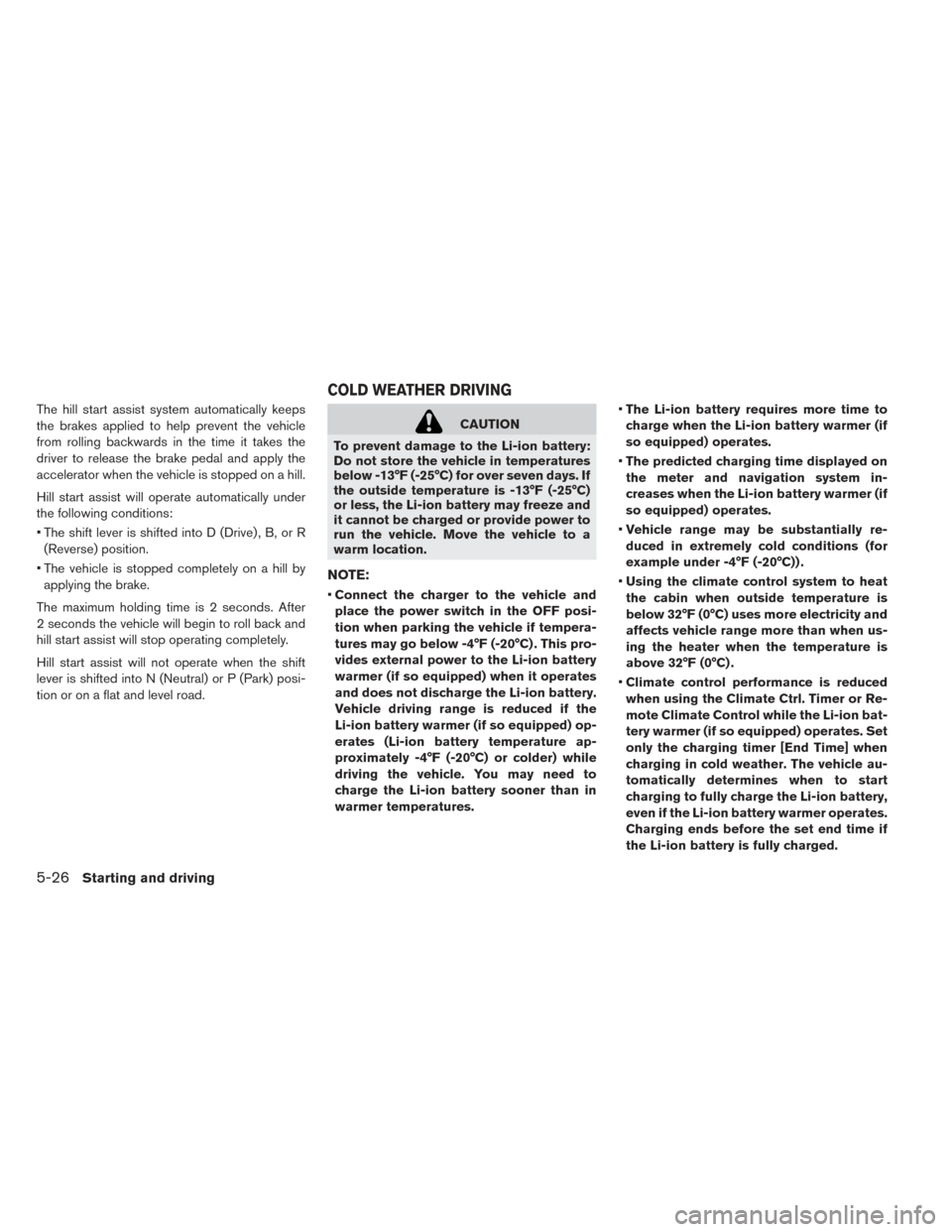
The hill start assist system automatically keeps
the brakes applied to help prevent the vehicle
from rolling backwards in the time it takes the
driver to release the brake pedal and apply the
accelerator when the vehicle is stopped on a hill.
Hill start assist will operate automatically under
the following conditions:
• The shift lever is shifted into D (Drive) , B, or R(Reverse) position.
• The vehicle is stopped completely on a hill by applying the brake.
The maximum holding time is 2 seconds. After
2 seconds the vehicle will begin to roll back and
hill start assist will stop operating completely.
Hill start assist will not operate when the shift
lever is shifted into N (Neutral) or P (Park) posi-
tion or on a flat and level road.CAUTION
To prevent damage to the Li-ion battery:
Do not store the vehicle in temperatures
below -13°F (-25°C) for over seven days. If
the outside temperature is -13°F (-25°C)
or less, the Li-ion battery may freeze and
it cannot be charged or provide power to
run the vehicle. Move the vehicle to a
warm location.
NOTE:
• Connect the charger to the vehicle and
place the power switch in the OFF posi-
tion when parking the vehicle if tempera-
tures may go below -4°F (-20°C) . This pro-
vides external power to the Li-ion battery
warmer (if so equipped) when it operates
and does not discharge the Li-ion battery.
Vehicle driving range is reduced if the
Li-ion battery warmer (if so equipped) op-
erates (Li-ion battery temperature ap-
proximately -4°F (-20°C) or colder) while
driving the vehicle. You may need to
charge the Li-ion battery sooner than in
warmer temperatures. •
The Li-ion battery requires more time to
charge when the Li-ion battery warmer (if
so equipped) operates.
• The predicted charging time displayed on
the meter and navigation system in-
creases when the Li-ion battery warmer (if
so equipped) operates.
• Vehicle range may be substantially re-
duced in extremely cold conditions (for
example under -4°F (-20°C)) .
• Using the climate control system to heat
the cabin when outside temperature is
below 32°F (0°C) uses more electricity and
affects vehicle range more than when us-
ing the heater when the temperature is
above 32°F (0°C) .
• Climate control performance is reduced
when using the Climate Ctrl. Timer or Re-
mote Climate Control while the Li-ion bat-
tery warmer (if so equipped) operates. Set
only the charging timer [End Time] when
charging in cold weather. The vehicle au-
tomatically determines when to start
charging to fully charge the Li-ion battery,
even if the Li-ion battery warmer operates.
Charging ends before the set end time if
the Li-ion battery is fully charged.
COLD WEATHER DRIVING
5-26Starting and driving
Page 333 of 424
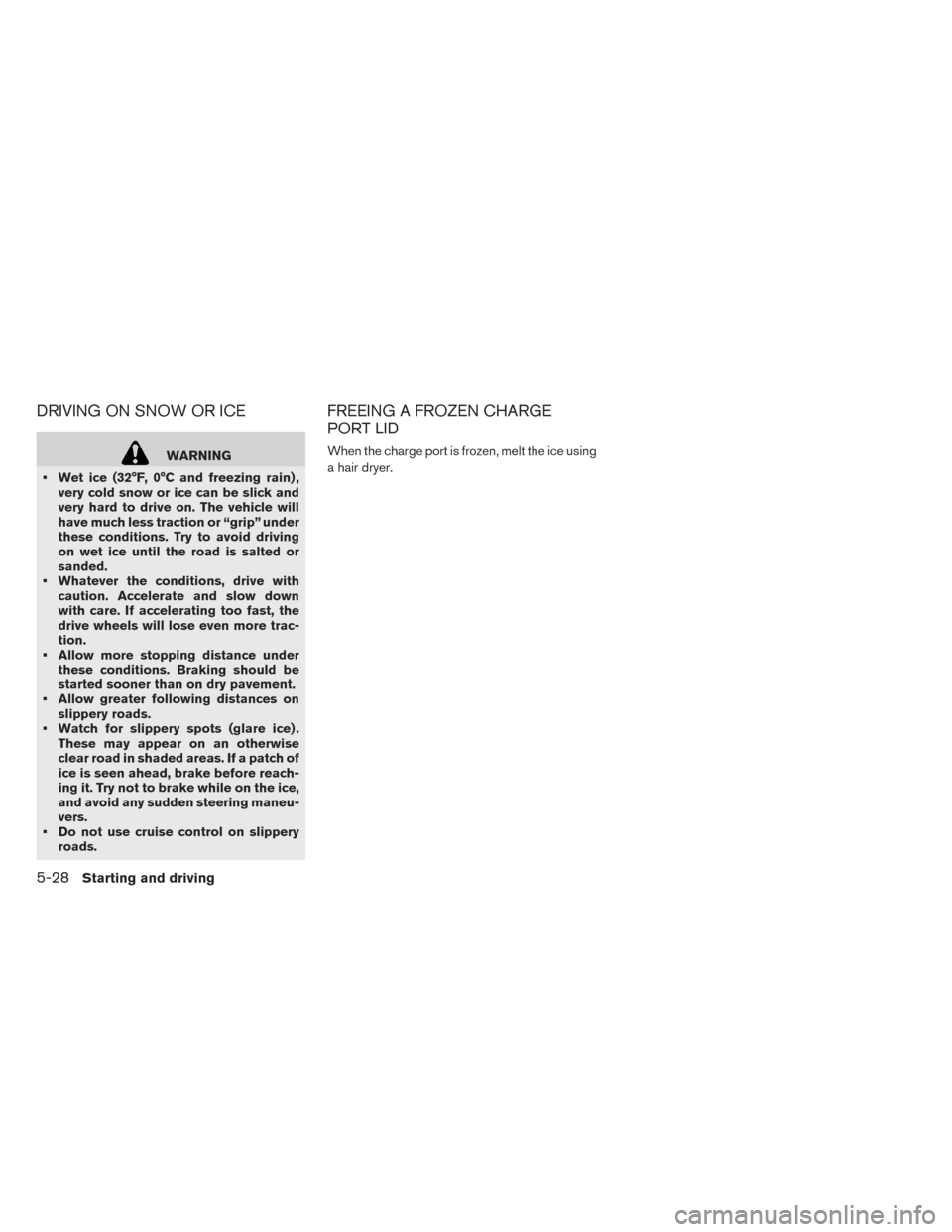
DRIVING ON SNOW OR ICE
WARNING
• Wet ice (32°F, 0°C and freezing rain) , very cold snow or ice can be slick and
very hard to drive on. The vehicle will
have much less traction or “grip” under
these conditions. Try to avoid driving
on wet ice until the road is salted or
sanded.
• Whatever the conditions, drive with caution. Accelerate and slow down
with care. If accelerating too fast, the
drive wheels will lose even more trac-
tion.
• Allow more stopping distance under these conditions. Braking should be
started sooner than on dry pavement.
• Allow greater following distances on slippery roads.
• Watch for slippery spots (glare ice) . These may appear on an otherwise
clear road in shaded areas. If a patch of
ice is seen ahead, brake before reach-
ing it. Try not to brake while on the ice,
and avoid any sudden steering maneu-
vers.
• Do not use cruise control on slippery roads.
FREEING A FROZEN CHARGE
PORT LID
When the charge port is frozen, melt the ice using
a hair dryer.
5-28Starting and driving
Page 336 of 424
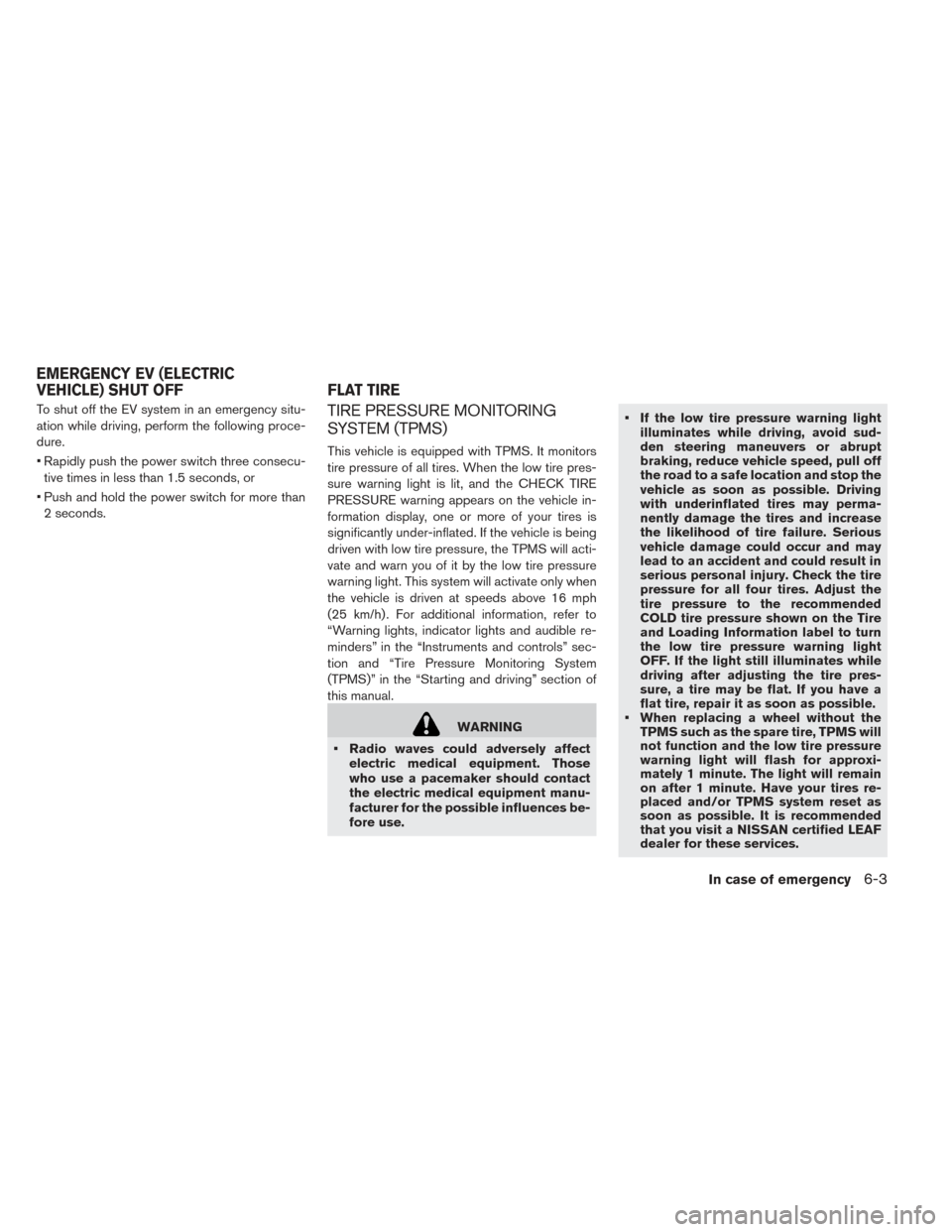
To shut off the EV system in an emergency situ-
ation while driving, perform the following proce-
dure.
• Rapidly push the power switch three consecu-tive times in less than 1.5 seconds, or
• Push and hold the power switch for more than 2 seconds.TIRE PRESSURE MONITORING
SYSTEM (TPMS)
This vehicle is equipped with TPMS. It monitors
tire pressure of all tires. When the low tire pres-
sure warning light is lit, and the CHECK TIRE
PRESSURE warning appears on the vehicle in-
formation display, one or more of your tires is
significantly under-inflated. If the vehicle is being
driven with low tire pressure, the TPMS will acti-
vate and warn you of it by the low tire pressure
warning light. This system will activate only when
the vehicle is driven at speeds above 16 mph
(25 km/h) . For additional information, refer to
“Warning lights, indicator lights and audible re-
minders” in the “Instruments and controls” sec-
tion and “Tire Pressure Monitoring System
(TPMS)” in the “Starting and driving” section of
this manual.
WARNING
• Radio waves could adversely affect electric medical equipment. Those
who use a pacemaker should contact
the electric medical equipment manu-
facturer for the possible influences be-
fore use. • If the low tire pressure warning light
illuminates while driving, avoid sud-
den steering maneuvers or abrupt
braking, reduce vehicle speed, pull off
the road to a safe location and stop the
vehicle as soon as possible. Driving
with underinflated tires may perma-
nently damage the tires and increase
the likelihood of tire failure. Serious
vehicle damage could occur and may
lead to an accident and could result in
serious personal injury. Check the tire
pressure for all four tires. Adjust the
tire pressure to the recommended
COLD tire pressure shown on the Tire
and Loading Information label to turn
the low tire pressure warning light
OFF. If the light still illuminates while
driving after adjusting the tire pres-
sure, a tire may be flat. If you have a
flat tire, repair it as soon as possible.
• When replacing a wheel without the TPMS such as the spare tire, TPMS will
not function and the low tire pressure
warning light will flash for approxi-
mately 1 minute. The light will remain
on after 1 minute. Have your tires re-
placed and/or TPMS system reset as
soon as possible. It is recommended
that you visit a NISSAN certified LEAF
dealer for these services.
EMERGENCY EV (ELECTRIC
VEHICLE) SHUT OFF FLAT TIRE
In case of emergency6-3